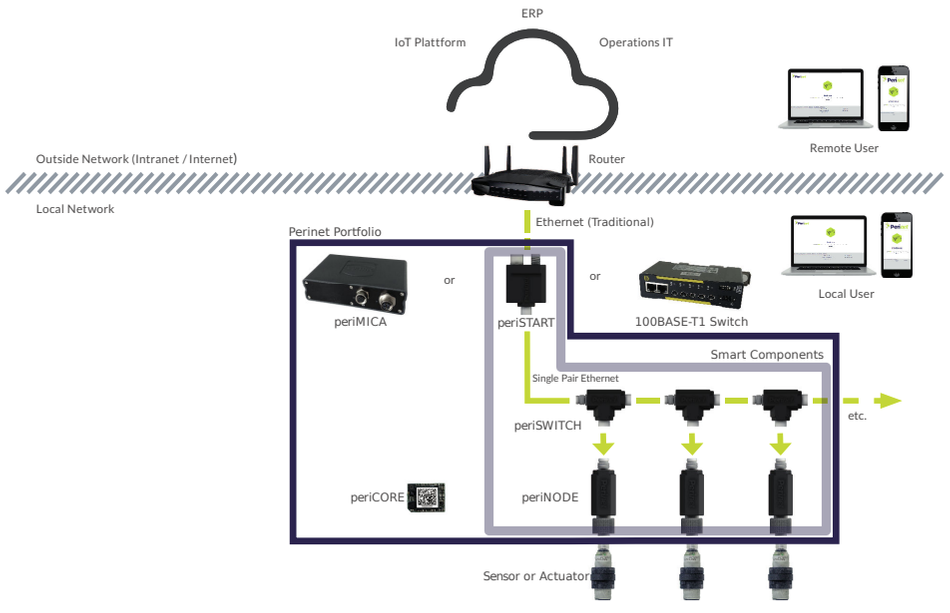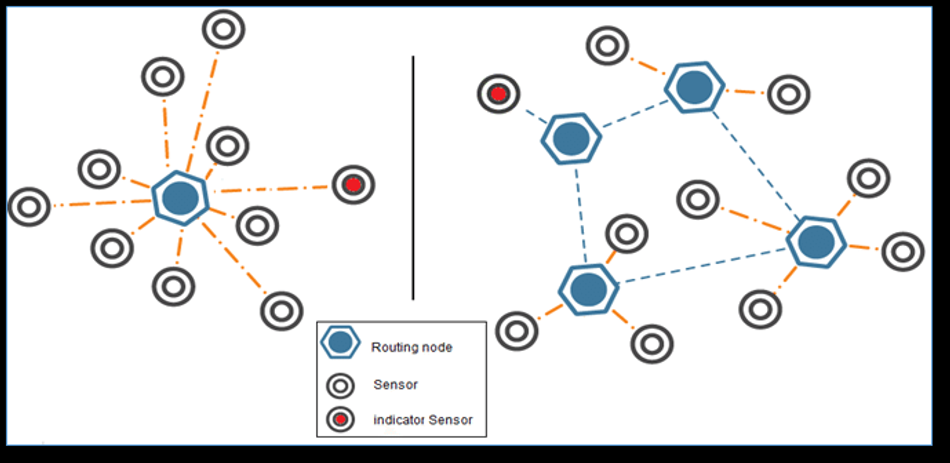IoT Solutions for Distributed Field-Level Sensor and Actuator Networks
Sensor and actuator networks are systems that collect and transmit data from a physical environment for digital processing. Data is collected at sensors and actuators in the field, then digitized at the sensor or actuator. The digitized data can be used for a variety of applications, and the method for data processing depends on the application
Introduction
In some applications, processing happens at edge devices in the immediate network. In others, the data is transmitted to a local area network and processed in the cloud. Sensor-to-node systems are used across industries for countless functions, including predictive maintenance, quality control, energy management, safety monitoring, security, and inventory management.
In physical environments, timely digitization of processes and guaranteed data delivery is critical for effective control and monitoring and requires seamless integration of field-level devices and operational IT systems [1]. Building robust infrastructure that bridges the gap between data hubs and field-level sensors and actuators is a challenge faced by industries today, and key IoT technologies and solutions are under development. In this article, we will explore current challenges in sensor-to-node systems. We will also introduce Perinet, a company at the forefront of IoT with innovations in sensor-to-IP systems, integrated security, and single-pair Ethernet (SPE) technology.
Understanding the Current State of IoT Sensor and Actuator Connectivity
The optimization of IoT sensor to node systems is often hindered by challenges that require multidisciplinary solutions. Here are a few of the major problems facing these systems.
- Security – Field-level sensors and actuators often work against security, making it difficult, sometimes impossible, to achieve end-to-end encryption. These devices may store sensitive data and encryption is essential to protecting data privacy and integrity. However, field-level devices are often resource-constrained, leaving them especially vulnerable to cyber attacks.[2]
- System compatibility – Sensors and actuators from different manufacturers may use divergent communication protocols and standards, which can impede effective communication between devices—a problem which may arise particularly when integrating a new system into an existing system. Other considerations include hardware interface compatibility, power requirements, and compatible operating systems, software, and applications.[3]
- Range – The range of connectivity is impacted by a number of factors, including device compatibility, power limitations, and network architecture. For example, a mesh network can use intermediate nodes to extend the range of a sensor-to-node system. Wireless signal propagation may be impacted by interference from other devices, obstructions, and environmental factors, like temperature, humidity, and atmospheric charge. [4]
Example of star and mesh networks, illustrating the greater range and scalability of mesh networks. Image source: ResearchGate.net
- Scalability – In a sensor to node system, considerations for scalability include security, network architecture, data management and storage, device and power management, and the operational IT that supports the network. An expanding company with legacy systems may require major internal reconfiguration and development at the software and hardware level in order to scale IoT systems along with the business.
- Data extraction – Sensor to node systems carry large amounts of data, and inefficient systems are subject to signal noise and errors, which can lead to major inaccuracies when the data is processed. Additionally, systems that use unstandardized devices make it difficult to extract and compare data consistently. These networks are vulnerable to data loss and fragmentation. [5]
- Power – Sensor and actuator systems require a continuous power supply and power monitoring to support connectivity and accurate and complete data collection. Battery-powered sensors and actuators must have adequate longevity for the application. [6]
Addressing the Challenges of IoT Networks
These challenges can be a daunting obstacle when it comes to establishing or scaling an IoT network. Solutions require optimized device designs, standardized communication protocols, security features, and data collection strategies. It is therefore critical to view the network as a whole, synchronized structure when designing a sensor to node system. In the following sections, we examine the solutions at Perinet, a company on the leading edge of IoT technology, and discuss the advantages of a standardized sensor to node ecosystem.
Overview of Perinet IoT Architecture
Perinet provides hardware and firmware for analog to digital data acquisition at sensors, as well as transmission of data over a lightweight SPE network. Perinet’s systems also incorporate lifecycle management, network stack, and security features. The following are distinguishing features of Perinet’s IoT architecture.
Single-pair Ethernet technology – Perinet’s IoT architecture leverages hybrid SPE technology to establish efficient and seamless connectivity between devices and nodes. This technology connects sensors and actuators to the network, with power supply and data transmission on separate pairs of wires, providing high-speed data transmission that is resistant to interference and signal noise.
Low-code development – Perinet’s low-code technology empowers users to develop IoT applications without extensive coding knowledge, streamlining the development process. Perinet handles most of the development work for users, including security, system lifecycle management, and network communication.
Seamless integration – Perinet’s solutions integrate seamlessly with existing systems, addressing the challenges of scalability and integration.
Edge applications – Edge processing moves computing into the field for improved reliability and faster access to information.
Use your branding – Perinet products can be labeled to integrate with your company’s branding.
Product modularity – Modular hardware and software results in a flexible and scalable system to meet requirements for specific applications.

Advantages of Perinet IoT
The Perinet IoT system provides beneficial solutions to the challenges faced by businesses that operate sensor to node systems.
Security – End-to-end encryption is one of the most advantageous features of Perinet’s IoT system. Advanced security measures are incorporated into Perinet’s IoT solutions and devices, safeguarding data and maintaining the integrity of the network, while requiring no additional configuration for security setup.
Extended range – Perinet’s single-pair Ethernet technology extends the range of connectivity so that field-level devices can communicate effectively over greater distances. Perinet has demonstrated 100Base-T1 communication across more than 100 meters between devices over an unshielded cable.
Interoperability – Perinet’s IoT architecture is designed to be compatible with a diverse array of devices and systems, ensuring a versatile and adaptable solution for scaling businesses.
Low-code – The low-code technology addresses the challenge of scalability by simplifying the development process, enabling users to build applications with minimal coding expertise.
Data extraction – Perinet’s solutions improve the efficiency of data extraction, facilitating better data collection by digitizing information at the sensor, and ultimately improving the overall performance of IoT systems.
Operational IT – Perinet’s IoT is standardized with IPv6 and Restful API for optimized communication between devices and seamless end-to-end encryption.
Understanding the Perinet IoT Ecosystem
The Perinet IoT ecosystem consists of several interconnected components:
Hardware components – These include the interfaces between sensors, actuators, IP communication, media converters, gateways, and the periCORE communication module. The periCORE PCB module enables easy integration of single-pair Ethernet technology with a variety of systems. Adaptors for sensors and actuators make it easy to digitize analog sensor data, while Linux-based containerized devices enable post-processing of data in the field.
Software components – Perinet's low-code platform allows users to create custom applications and manage their IoT systems effectively. The user-accessible firmware development environment provides customization of firmware for specific use cases.
Perinet IoT Applications
Perinet's IoT solutions cater to industrial and general purpose applications, including:
Smart buildings – Enhancing building automation, energy management, and occupant comfort through integrated IoT systems.
Agriculture – Using IoT technology to optimize crop management, livestock monitoring, and resource allocation.
Transportation – Empowering fleet management, route optimization, and vehicle maintenance through data-driven insights.
Energy management – Streamlining energy consumption, distribution, and conservation efforts with IoT-enabled solutions.
Conclusion
Sensor to node networks are a powerful tool for a wide range of industries and applications, but implementing and maintaining these systems can be complex and challenging. To overcome issues related to security, system compatibility, connectivity range, scalability, data extraction, and power management, Perinet offers an innovative IoT platform that combines hardware, software, and security solutions into an integrated ecosystem. With features like integrated security, low-code implementation, and single-pair Ethernet technology, real-time monitoring, and predictive maintenance, Perinet delivers a comprehensive and flexible IoT solution that can provide significant value to its users. For more information about Perinet’s IoT platform and its capabilities, please visit https://www.perinet.io/en.
References
[1] H. Liazad and M. Lehsaini. (2021). “A brief review on integration between wireless sensor networks and Cloud”. Wiley Online Library. Accessed April 2023 from https://onlinelibrary.wiley.com/doi/10.1002/cpe.6328.
[2] S. Tata, R. Jain, H. Ludwig and S. Gopisetty (2017). "Living in the Cloud or on the Edge: Opportunities and Challenges of IOT Application Architecture," 2017 IEEE International Conference on Services Computing (SCC). Accessed April 2023 from https://ieeexplore.ieee.org/abstract/document/8034988.
[3] S. Tata, et al (2017).
[4] J. Li, L.L. Andrew, C.H. Foh, M. Zukerman, H.H. Chen (2009). “Connectivity, coverage, and placement in wireless sensor networks”. National Library of Medicine. Accessed April 2023 from https://www.ncbi.nlm.nih.gov/pmc/articles/PMC3292077/.
[5] S. Tata, et al (2017).
[6] Kumari, Neetu & Patel, Nikita & Anand, Satyajit & Bhattacharya, Partha & Tech, M. (2013). “Designing Low Power Wireless Sensor Networks: A Brief Survey”. International Journal of Advanced Research in Electrical, Electronics, and Instrumentation Engineering. Accessed April 2023 at https://www.researchgate.net/publication/306000070_Designing_Low_Power_Wireless_Sensor_Networks_A_Brief_Survey.


